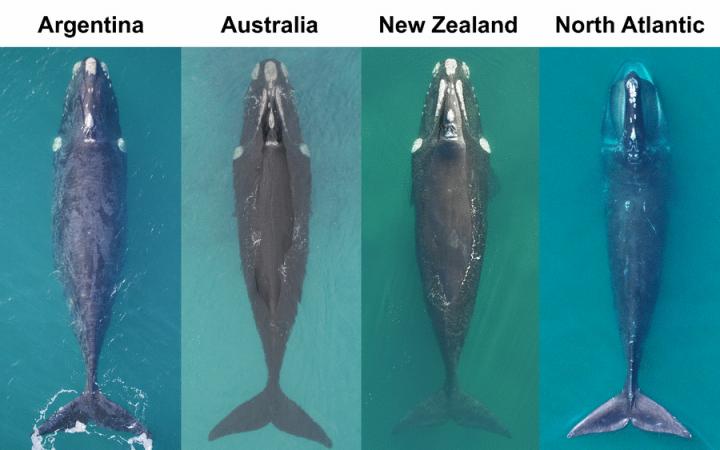
Credit: Photos: Fredrik Christiansen (left & center-left), Stephen M. Dawson (center-right), John W. Durban and Holly Fearnbach (right).
BOSTON, MASS. (April 23, 2020) – New research by an international team of scientists reveals that endangered North Atlantic right whales are in much poorer body condition than their counterparts in the southern hemisphere.
This alarming research, led by Dr. Fredrik Christiansen from Aarhus University in Denmark, was published this week in the journal Marine Ecology Progress Series. The study is the result of a collaborative effort by scientist from 12 institutions across 5 nations. Among the coauthors are Senior Scientist Peter Corkeron and Associate Scientist Heather Pettis of the Anderson Cabot Center for Ocean Life at the New England Aquarium and Michael Moore and Carolyn Miller of the Woods Hole Oceanographic Institution.
The analyses revealed that individual North Atlantic right whales–juveniles, adults and mothers–were all in poorer body condition than individual whales from the three populations of Southern right whales. This is alarming, since poor body condition for North Atlantic right whales helps explain why too many of them are dying and why they are not giving birth to enough calves. It could also be affecting their growth and delaying juveniles reaching sexual maturity. These combined impacts on individuals help explain why the species is in decline.
Since the cessation of large-scale commercial whaling in the last century, most populations of southern right whales have recovered well. Now there are about 10,000-15,000 southern right whales. Unfortunately, the same cannot be said for the North Atlantic right whales, found today mostly off the east coast of North America. There are now around 410 individuals left, and the species is heading to extinction. Lethal vessel strikes and entanglement in fishing gear continue to kill these whales. Individual North Atlantic right whales also have to cope with the energetic expense and other costs that are caused by frequent entanglements in fishing gear, in particular lobster and crab pots. These burdens, along with a change in the abundance and distribution of the rice-sized plankton that they eat, have left these whales thin and unhealthy, which makes them less likely to have a calf. This, in turn, contributes to the current overall decline of the species. To quantify “thin and unhealthy,” Dr. Christiansen and his colleagues investigated the body condition of individual North Atlantic right whales and compared their condition with individuals from three increasing populations of Southern right whales: off Argentina, Australia and New Zealand.
“Good body condition and abundant fat reserves are crucial for the reproduction of large whales, including right whales, as the animals rely on these energy stores during the breeding season when they are mostly fasting,” said Dr. Christiansen. Stored fat reserves are particularly important for mothers, who need the extra energy to support the growth of their newly born calf while they are nursing.
The study is the largest assessment of the body condition of baleen whales in the world. The international research team used drones and a method called aerial photogrammetry to measure the body length and width of individual right whales in these four regions around the world. From aerial photographs, the researchers estimated the body volume of individual whales, which they then used to derive an index of body condition or relative fatness.
“This started out as a conversation between a few of us over dinner at a conference in 2015. Now that the results are out, they’re quite shocking,” said Peter Corkeron of the Anderson Cabot Center for Ocean Life at the New England Aquarium. “We know that North Atlantic right whales as a species are doing poorly, but this work brings home that as individuals, they’re also doing poorly. Their decline has been so rapid that we know it’s not simply because not enough calves are being born – too many whales are also dying from human-caused injuries. But this study also shows that their decline isn’t solely due to these deaths. Their problems are more insidious, and we need to find a way to ensure that the health of all individual whales improves.”
“For North Atlantic right whales as individuals, and as a species, things are going terribly wrong. This comparison with their southern hemisphere relatives shows that most individual North Atlantic right whales are in much worse condition than they should be,” said Michael Moore from the Woods Hole Oceanographic Institution. “As a veterinarian, I’ve long been concerned about how entanglements affect the welfare of these whales. Now we are starting to draw the linkages from welfare to this species’ decline. Sub-lethal entanglement trauma, along with changing food supplies is making them too skinny to reproduce well, and lethal entanglement and vessel trauma are killing them. To reverse these changes, we must: redirect vessels away from, and reduce their speed in, right whale habitat; retrieve crab and lobster traps without rope in the water column using available technologies; and minimize ocean noise from its many sources.”
This work was supported by funding from NOAA, US Office of Naval Research Marine Mammals Program, World Wildlife Fund for Nature Australia, Murdoch University School of Veterinary and Life Sciences, New Zealand Antarctic Research institute, Otago University and New Zealand Whale and Dolphin Trust and Argentina National Geographic Society.
For 40 years, the New England Aquarium’s right whale team has extensively researched and tracked individual right whales and curates the North Atlantic Right Whale Catalog. The scientific team monitors the whales’ arrival at breeding and feeding grounds, registering new calves, death rates, and also measuring changes in stress and reproductive hormones.
The Woods Hole Oceanographic Institution is dedicated to advancing knowledge of the ocean and its connection with the Earth system through a sustained commitment to excellence in science, engineering and education, and to the application of this knowledge to problems facing society.
###
Media Contact
WHOI Media Office
[email protected]




